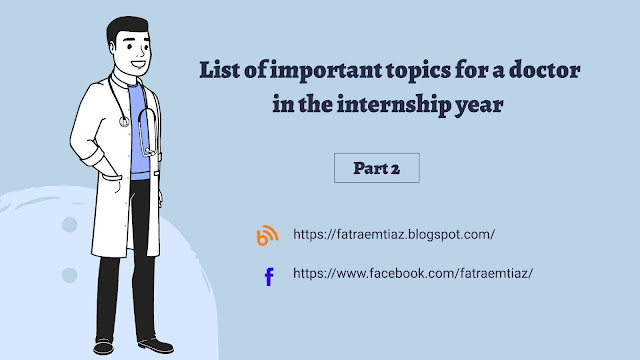Skills you need to learn as an inten doctor ! part 2
: قائمة بالموضوعات اللى المفروض تسعى بشكل جدى كطبيب امتياز أو كطبيب ممارس عام أنك تتعلمها فى سنة امتياز طب
1-
Learn to give injections
intravenously, intramuscularly and SC and ID
2-
Learn to draw and interpret blood
samples from veins and arteries.
3-
How to draw different blood samples
(as you may be asked in different settings to perform them instead of the
nursing staff )
4-
Learn to insert the intravenous line
known as the cannula. (And to differentiate between different sizes and colors)
in adults and children.
5-
Learn to insert the central line in
the veins of the neck (or at least observe how it is done by another senior
doctor)
6-
Learn how to perform blood type and
rhesus.
7-
Learn to read x-rays of all kinds,
as well as Ultrasound images.
8-
Learn to listen to the chest, heart,
and stomach.
9-
Learn to examine the patient's
entire body as it is written in books on internal medicine and surgery.
10- Learn
to examine the nose, ears, throat, and eyes extensively from what was studied
in the school years and to learn the most common clinical presentation that you
can see as OPC.
11- Learn
to examine and describe different skin conditions extensively from what was
studied in the school years and to learn the most common clinical presentation
in each rotation that you can see as OPC.
12- Learn
to measure pressure by both methods and the pulse, as mentioned in books on
cardiology.
13- Learn to read and interpret different lab
values.
14- How
to assist in operative theatre
15- How
to assist in ITU and ER resus room
16- Learn
to read the ECG and how to perform it with the device.
17- Learn
to read the EEG and the audiometer. (or at least observe how it is done or how
it looks like)
18- Learn
to read the CTB and fetal heart sounds. (or at least observe how it is done or
how it looks like)
19- Learn
to calculate the quantity and rate of medicines according to age and weight for
common and other emergency medicines for children and adults.
20- Learn
the composition of solutions, plasma and blood bags, and the precautions that
must be taken before administration.
21- Learn
to calculate the rate of Fluids drop per hour.
22- Learning
how to relocate joints and apply cast and slabs and treat different fractures
for orthopedic patients. (Do not forget to perform and manage venous
thromboembolism)
23- Learn the principles of delivery in the labor wards in the Gynecology and
obstetrics department.
24- Learn
how to perform intimate parts examination with written or verbal consent and
chaperone from the same gender and document the name and the role of chaperone
25- Learn how to assist in minor surgeries
(suturing and abscess , wound dressing etc )
26- Learn
to insert the rail tube into the stomach
27- Learn to insert the urinary catheter with
different sizes and how to differentiate between types and colors and uses of
urinary catheters
28- Learn
to read the volume and colors and identify the nature of the fluids coming out
of the patient's body (urine bags , ascites bags etc )
29- Learning
to suture open wounds, except for the wounds of patients whose DM is not well
controlled or a complicated wounds and needs a senior review
30- How
to review post operative patient and management of post operative complications
31- Learn
to read and interpret the monitors inside the operating and ITU rooms
32- 29-
Learn how to deal with poison patients and how to perform 1st aid and how to
differentiate and treat different toxidromes
33- Learn
to manage airway in patient with a compromised airway
34- Learn
to manage and treat asthma and COPD exacerbation and how to install nebulizers
and how to administer them to the patient and how to teach them how to use
inhalers and nebulizers.
35- Learn
how to perform cardiopulmonary resuscitation (CPR)
36- Learn
to connect the dialysis machine as well as the peritoneal dialysis.
37- Learn
to write medical prescriptions with clear and valid details with patient ID,
address, diagnosis, weight, allergy and duration in clear letter and numbers
and formulation.
38- Learn
the clinical knowledge and guidelines about each rotation before it starts for
the most common clinical presentation you expect to see in the ward rounds
(before or after the ward rounds)
39- How
to present history and examination to the consultant or senior doctor
40- How
to present your clinical case during the ward round, handover or the discussion
with senior or colleagues or the teaching sessions
41- How
to prepare for a teaching session to your colleagues or nurses
42- How
to diagnose and confirm death and report it
43- How
to perform valid referral to different department.
44- How
to assist and be involved in patient transfer between different department and
hospitals
45- How
to know the national immunization table




Comments
Post a Comment